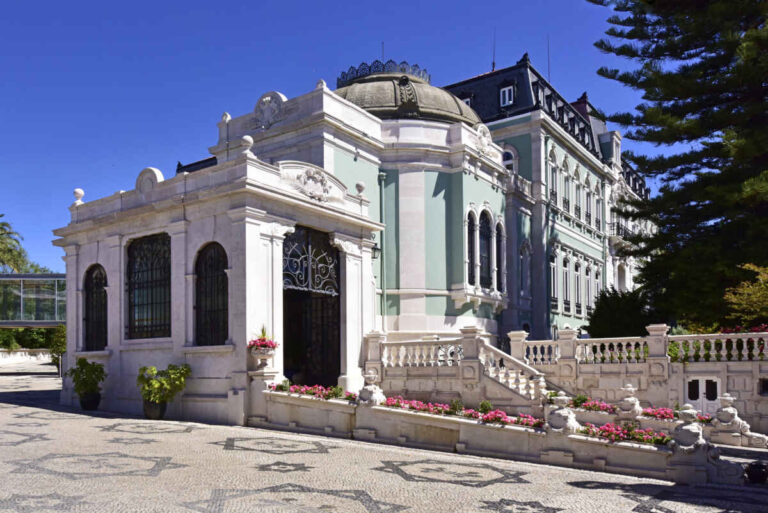
Photos, history and review the Pestana Palace, Lisbon.
The city of Lisbon offers several hotels in historic palaces. Probably the most exiting of them is the Pestana Palace, a five-star luxury hotel situated in the historic Valle Flôr Palace.
The historic part of the Pestana Palace is both, a historic landmark of museum quality and a hotel offering contemporary luxury.
The first owner of the palace, the Viscount, Count and subsequently Marquis of Valle Flôr, started as a modest farmer in S. Tomé and Príncipe, to become one of the leading cocoa producers. He also became a member of parliament and a friend of King D. Carlos.
His Golden River Plantation was considered to be a model plantation on the island. It included a hospital and a school for the children and the workers. At the same time, the salaries were miserable, and four Africans were forced into lifelong “contracts”, renewable every three years.
Over the years, his luxury property in Lisbon, the Valle Flôr Palace, had been severely deteriorated both inside and outside. The magnificent stained glass windows, the woodwork, the furniture and the artwork of the palace were still impressive. The property also included a lake and a garden. The state failed to acquire it due to budgetary concerns. António de Almeida Santos was a minister in the government Soares and suggested to his friend, Dr. Dionísio Pestana, to purchase the property and turn it into a luxury hotel. Initially, Pestana was unable to buy the horse stable block, situated on the other side of the street. Today, it is the hotel’s conference center, also used for weddings and other private functions.
With skill and sensitivity, Pestana restored the palace with its paintings, ceilings, panels, stained glass and furniture and painstakingly redeveloped the exotic garden to its former glory.
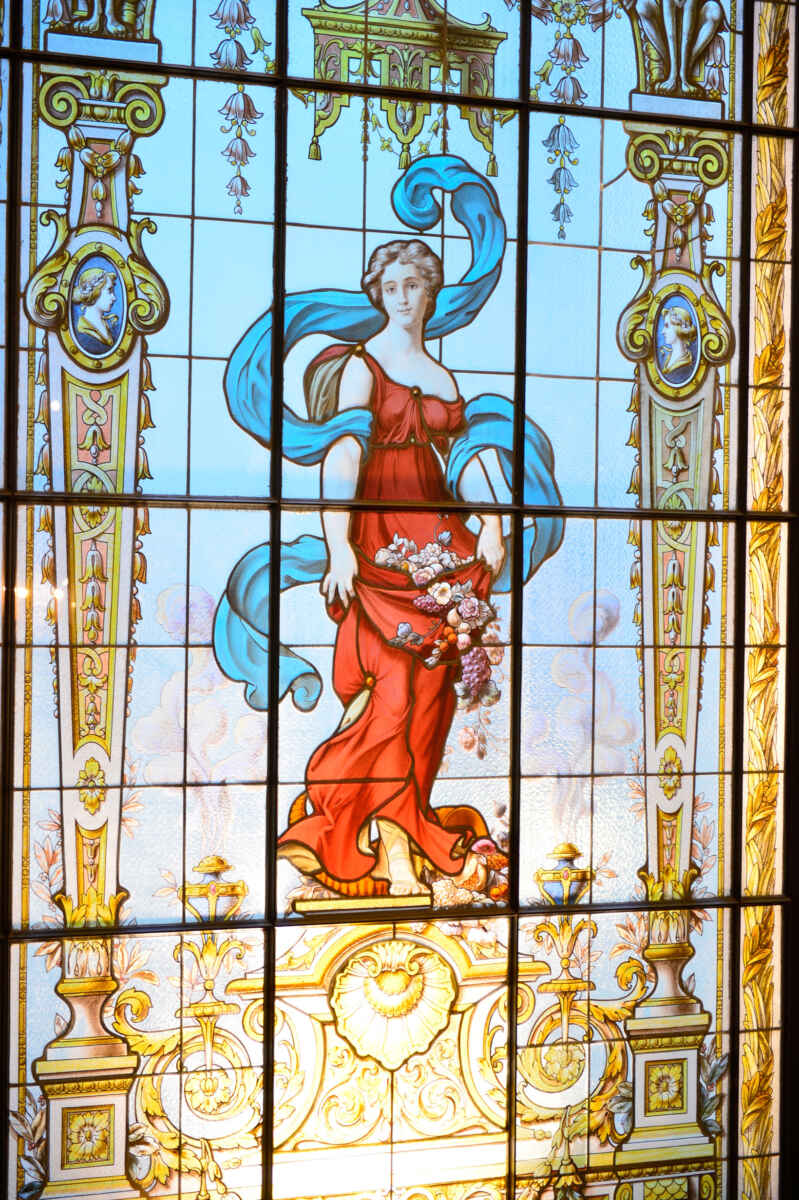
Beautifully restored stained glass at the historic Pestana Palace, Lisbon.

The Marquis of Valle Flôr
The Pestana Palace was built on the S. Amaro Hill (Alto de Sto. Amaro). The area to the west of Lisbon was at the time far from the city center. It was a natural belvedere overlooking the river Tejo. The palace was built on the wide green landscape, not as part of the city of Lisbon.
The Marquis of Valle Flôr purchased the property on the hill around 1890. José Luís Constantino was a man born in Murça, Trás-os-Montes in 1855. At the age of 16, he sailed to the island of S. Tomé, an archipelago discovered by the Portuguese in 1471. The unpopulated island became a source of wealth to Portugal. Between 1912 and 1915, the island of S. Tomé and Príncipe was the world’s largest cocoa producer. The Marquis of Valle Flôr was the most important individual in this business.
His huge Rio d’Ouro plantations included beaches, bays and small harbors. In addition to cocoa, he grew sugar cane, coffee and palm oil. The Marquis of Valle Flôr acquired one of Portugal’s largest fortunes of the 20th century. His achievements were recognized by the son of King D. Carlos, His Royal Highness Prince D. Luís Filipe, in a visit paid to the island. The Portuguese colonies were under pressure from other European powers, notably England. The Prince praised Viscount of Valle Flôr, then Mayor, for the modern organization and management of his plantation and his hospital.
A Viscount since 1890, he was a member of the Regeneration Party. He was nominated a Peer of the Kingdom by the government of Teixeira de Sousa, but never took office because of the establishment of the Republic. In 1907, the King invested him with the title of Marquis.
The cocoa farmer’s wife, D. Maria do Carmo Dias Constantino, was a dedicated friend to the Queen D. Amélia. She established the Fundaçao Valle Flôr in memory of her late children. Its purpose is to award children who distinguish themselves by deeds of character and kindness. The awards are presented in an annual public ceremony.

View of the Renaissance Room at the Pestana Palace, Lisbon.
The Palace Valle Flôr
In 1904, the Palace Valle Flôr was originally conceived by the Italian Venitian architect Nicola Bigaglia (1841-1908). In 1910, the architect José Ferreira da Costa took charge of the construction, with the architect Ventura Terra contributing the drawing of some of the details.
The Marquis of Valle Flôr died in Nauheim health spa in Germany in 1932. Subsequently, the building began to decline. It had been forgotten for more than half a century, last occupied by the Centre for History and Ancient Cartography and then abandoned.
The building, a mix of Romanticism and Revivalism in a symmetric design and a theatrical appearance, was bought by the Pestana Group in 1992 and classified as a national monument in 1997.
The palace has four floors. Especially on two floors, the impressive work of the architects, sculptors, painters, marblers, gilders, cabinet-makers, ceramists and blacksmiths gives each room and salon a unique decorative character.
The influence of French art is strong, especially of the 18th and 19th century. The style is ornamental and opulent. Large canvases in the ceiling of the salon floor by Constantino Fernandes represent feasts and dances in soft colors, creating an atmosphere between dream and reason, as Zita Magalhães, the writer of a valuable publication about the palace, puts it.
Several ceilings and door tympana are decorated with 1900 paintings by Carlos Reis (1863-1940). He belonged to the second generation of landscape painters of naturalism. He founded the Outdoor Group (Grupo Ar-Livre). His palace works show flower garlands, trimmed shells, laurels and rushes painted with pastel colored curves. Mirrors and appliqués are contributing to the decorative exaltation.
One room is in the Renaissance style, another one offers a Japanese decor with works by Eugénio Cotrim with lilies, peonies, cherry flowers and almond trees.
The paintings in the Renaissance room are by the naturalist painter Domingos Costa, executed with thematic simplicity and technical skills. He was a disciple of Silva Porto and Veloso Salgado.
All the palace’s stained glass was made in Lisbon in the workshop of Cláudio Martins, the leading artist of his time, remarkable for the technique, color and themes of the stained glass he produced. He is known for his “aesthetics of light”. The studies for the female figures were completed by the Portuguese painter Conceiçao Silva (1869-1958), known for his rigorous drawings. He has not produced stained glass other than the one at Valle Flôr Palace.
The palace has its own chapel. Its stained glass was made later and is different, designed by the architect and constructor Ferreira da Costa in the atelier mentioned above.
The stuccos in the Valle Flôr Palace have been restored by a highly skilled team. The furniture, carved wood, floors and construction wood needed special attention, but was well preserved due to the high quality of woods imported from the island of S. Tomé.
Tiles have been associated with architecture since the 15th century and became a constant decorative resource in Portuguese art, as Zita Magalhães points out. In the Valle Flôr Palace they are present in interior coverings with floral motifs and reliefs. Their main function is to protect the walls. They only needed minimal restoration.

View of the D. Amélia Suite at the five-star Pestana Palace, Lisbon luxury hotel.
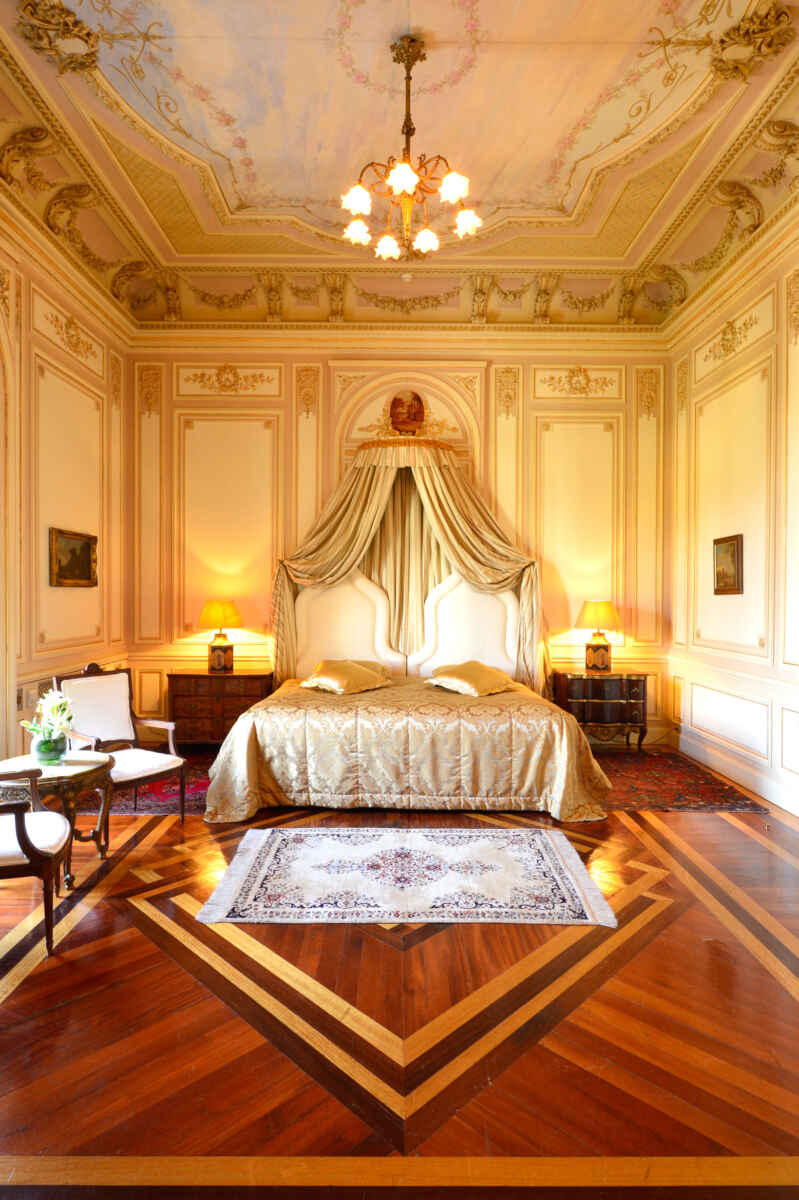
View of the D. Carlos Suite at the five-star Pestana Palace, Lisbon luxury hotel.
The Pestana Palace five-star hotel in Lisbon
The luxury hotel began its life under the name Carlton Palace Hotel and only adapted later the name of Pestana Palace. The flagship hotel had to reflect the Pestana Group’s name.
The 2002 report by the architect Manuel Tainha illustrates the situation of the palace at the moment of its reopening as the Carlton Palace Hotel on March 18, 2001.
The palace and park had to be kept together. Two new and low wings were added to the historic building. I stayed in one of the new wings, in the superior room 2026 with a terrace and a splendid garden view.
If you can afford it and if you prefer historic rooms, stay at the historic Valle Flôr Palace. The Marquis’ private apartments have been transformed into suites. The number of suites is limited, book in advance. The new east wing is linear and narrow in form. The new west wing was built on an area which was previously without plants. North of the west wing is a health club with an indoor and an outdoor pool as well as a gym, where I had to work out to get rid of my extra kilos gladly put on thanks to the fabulous pastry chef, Pedro Campas, a serial winner of the title of Best Chocolatier of the Year in Portugal. I tested several of his award-winning desserts. They were all outstanding. The restaurant mainly offers traditional Portuguese cuisine, which is not ideal for vegetarians like me, but don’t worry, I did not leave hungry.
The hotel interior architects were Jaime Morais and Pedro Espírito Santo. The Prietzel family helped Pestana since 1998 to collect fine works of art in Europe, which now complement what had remained of the historic interior design and architecture.
The hotel garden was the work of the landscape architect Júlio Moreira, who pointed out that a garden alters over time. It is inspired by the remains of the original structure and the oldest botanical species. He saved as much of the preexisting structure and vegetation as possible. The gardens had been abandoned, overgrown and imbalanced. The floral bushes and herbaceous plants were completely lost. Instead, 301 trees had flourished and taken over the gardens. The main objective was to rebuild the atmosphere and the spirit of the original park. Preserving original trees and choosing the right plants – bushes, new trees, herbaceous flowers. Moreira’s main task was to fill in spaces opened by removing infesting plants. There was no description of the original composition of the garden. Moreira and his team resorted to the favorite palette of impressionist painters for the gardens in the South of France to recreate the Park of Valle Flôr Palace.
In addition to the historic palace and park, the Pestana Palace offers what you normally expect in a luxury hotel: flat screen TVs, DVD players, kettles and tea bags in all rooms, a gym, in indoor and an outdoor pool. Its uniqueness stems from being a national monument with an historic garden. The Pestana Palace fully deserves to be a part of the exclusive Leading Hotels of the World.

View of the swimming pool at the Pestana Palace, Lisbon.
The Pestana Group
Dr. Dionísio Pestana, the chef of the Pestana Group, said at the opening of the Pestana Palace in 2001 that his father, Manuel Pestana, had correctly read the economic future of Portugal a few decades ago by predicting a booming tourism industry (which holds still true, despite the current economic crisis). Thirty years ago, on the Island of Madeira, Dr. Dionísio Pestana began his hotel business. In 2001, the Pestana Group already offered some 10,000 beds and employed a staff of 3,000 people, making it Portugal’s largest hotel group.
Dionísio Pestana described tourism as more than a business, a cultural exchange making the world smaller and increasingly known. By preserving the historic Valle Flôr Palace and its gardens, he contributed to the preservation of Portugal’s national heritage.
Literature
Hotel review added on October 10, 2010. Added to our newly designed pages with new photos on October 2, 2020. All photos copyright Pestana Palace Lisbon.
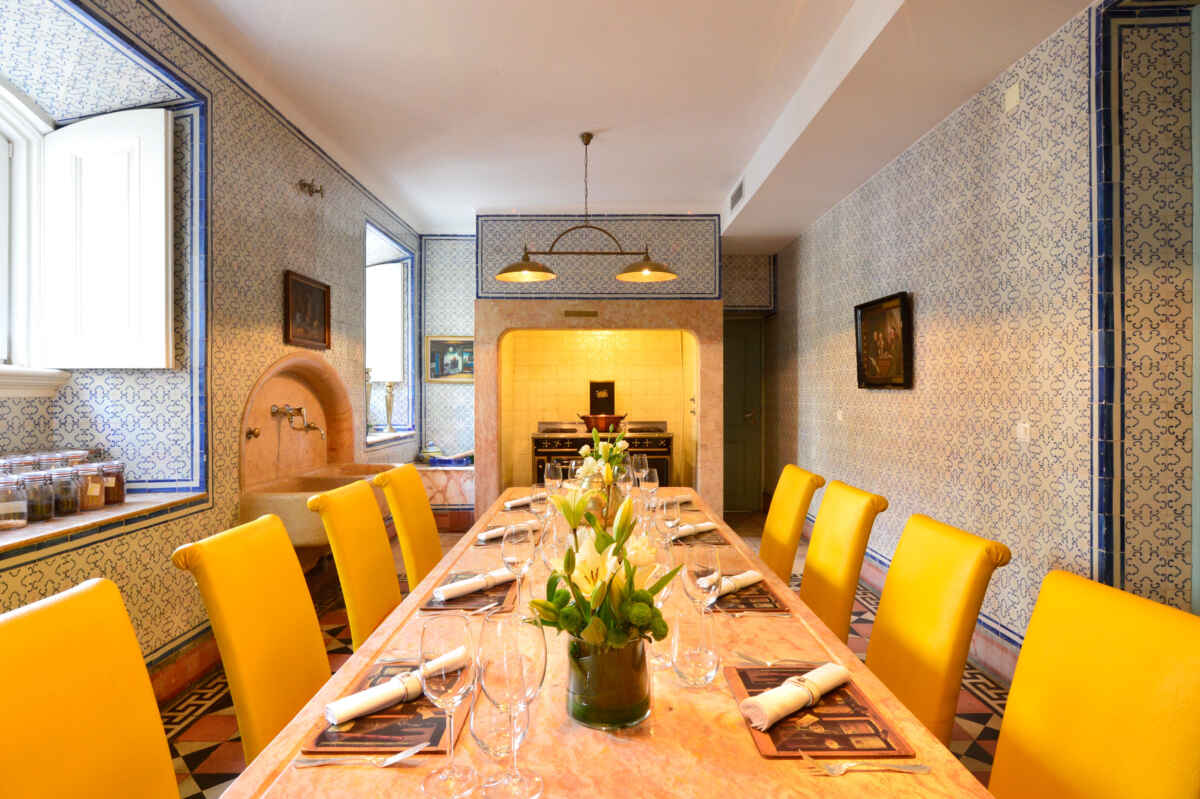
Pestana Palace, Lisbon. View of the historic kitchen which can be used for fine dining.
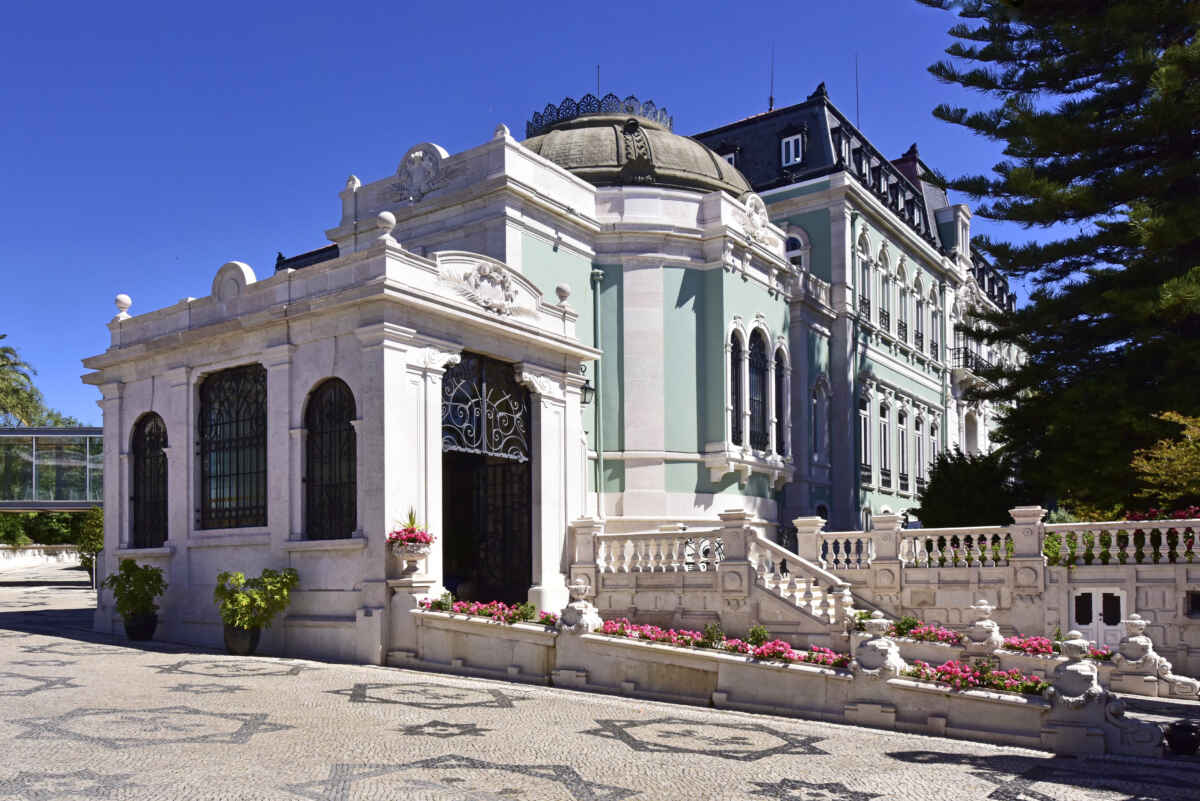
When I visited the Pestana Palace in Lisbon for the first time in 2010, the façade was yellow. New photograph added on Octobe 2, 2020. All photos copyright of the Pestana Palace Lisbon.